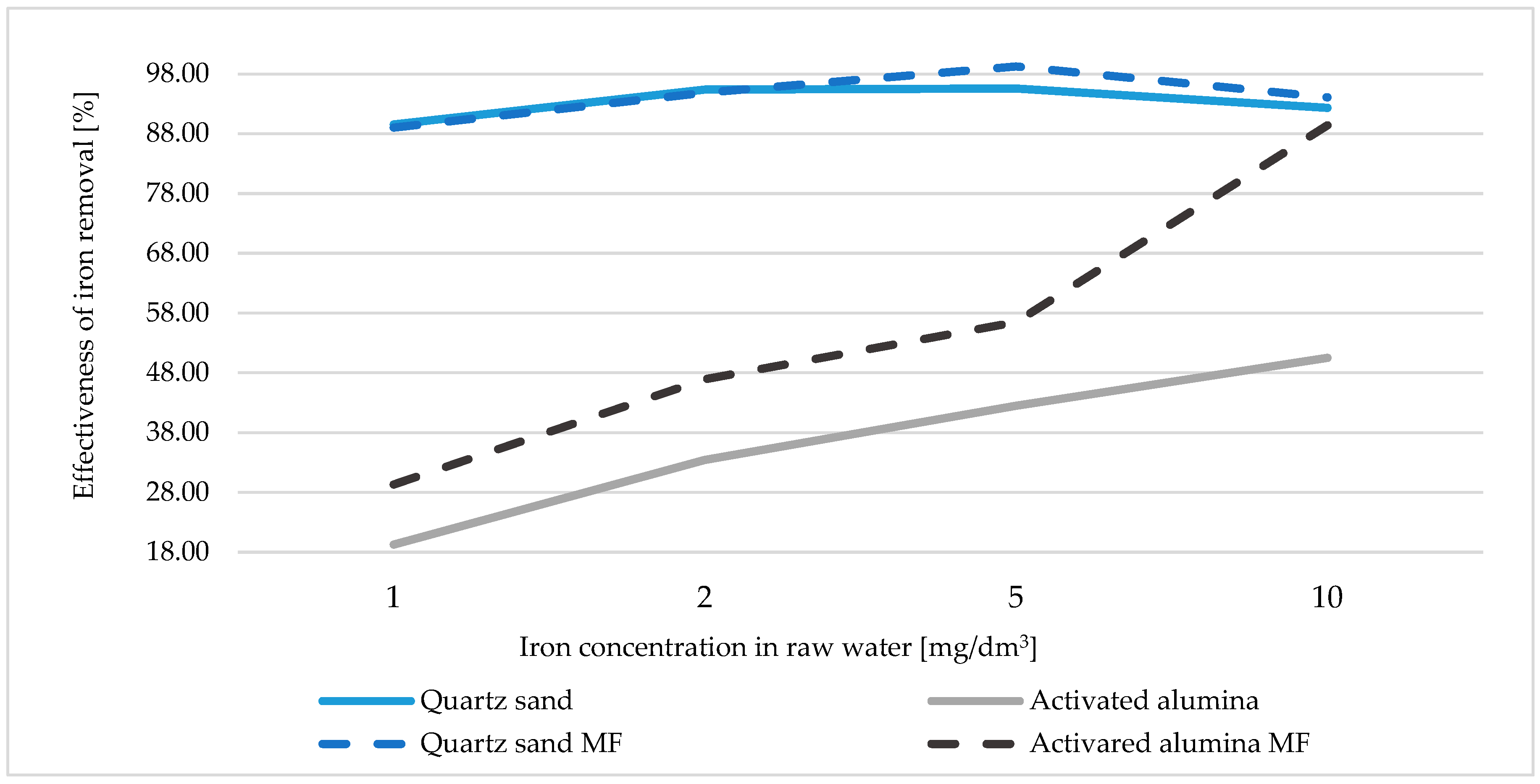Magnetic Field Usage for the Removal of Iron by Filtration-Assisted Different Filter Materials †
Abstract
:1. Introduction
2. Material and Methods
3. Results and Discussion
4. Conclusions
- The filter material more susceptible to the influence of the MF was activated alumina, in comparison to the quartz sand.
- In the process of removing iron compounds from the model water, comparable results were achieved both with magnetized and control water by quartz sand.
- The influence of the MF on the efficiency of iron removal increased with the increase of the initial concentration of iron in the water before the process, in the case of the filtration process on the activated alumina.
Author Contributions
Conflicts of Interest
References
- Skoczko, I.; Szatyłowicz, E. Removal of heavy metal ions by filtration on activated alumina-assisted magnetic field. Desalin. Water Treat. 2018, 117, 345–352. [Google Scholar] [CrossRef]
- Xiao, Z.; Zhou, Q.; Qin, H.; Qiao, J.; Guan, X. The enhancing effect of weak magnetic field on degradation of Orange II by zero-valent iron. Desalin. Water Treat. 2016, 57, 1659–1670. [Google Scholar] [CrossRef]
- Szcześ, A.; Chibowski, E.; Hołysz, L.; Rafalski, P. Effects of static magnetic field on water at kinetic condition. Chem. Eng. Process. 2011, 50, 124–127. [Google Scholar] [CrossRef]
- Toledo, E.J.L.; Ramalho, T.C.; Magriotis, Z.M. Influence of magnetic field on physical–chemical properties of the liquid water: Insights from experimental and theoretical models. J. Mol. Struct. 2008, 888, 409–415. [Google Scholar] [CrossRef]
- Skoczko, I.; Szatyłowicz, E. Studies on the efficiency of groundwater treatment process with adsorption on activated alumina. J. Ecol. Eng. 2017, 18, 211–218. [Google Scholar] [CrossRef]
- Singh, T.S.; Pant, K.K. Equilibrium, kinetics and thermodynamic studies for adsorption of As(III) on activated alumina. Sep. Purif. Technol. 2004, 36, 139–147. [Google Scholar] [CrossRef]
- Skoczko, I.; Piekutin, J.; Roszczenko, A. Removal of iron and manganese compounds from water. Annu. Set Environ. Prot. 2015, 17, 1587–1608. [Google Scholar]

| Diameter | Height | Magnetization Direction | Density | Resistivity | Ind. of Remanence | Weight |
|---|---|---|---|---|---|---|
| 50 [mm] +2.5%/−2.5% | 10 +0.1/−0.1 [mm] | along dimension | 4.5 [g/cm3] | 104–108 [Ohm·cm] | 0.37 [T] | ~88.3 [g] |
| Parameter | Raw Water | Quartz Sand | Activated Alumina | ||
|---|---|---|---|---|---|
| Sample | CS | MF | CS | MF | |
| Concentration 1 mg/dm3 | 0.95 ± 0.03 | 0.099 ± 0.012 | 0.104 ± 0.010 | 0.767 ± 0.013 | 0.672 ± 0.015 |
| Concentration 2 mg/dm3 | 1.92 ± 0.05 | 0.088 ± 0.003 | 0.098 ± 0.012 | 1.278 ± 0.016 | 1.019 ± 0.011 |
| Concentration 5 mg/dm3 | 4.89 ± 0.12 | 0.216 ± 0.014 | 0.037 ± 0.008 | 2.813 ± 0.067 | 2.128 ± 0.085 |
| Concentration 10 mg/dm3 | 9.45 ± 0.18 | 0.726 ± 0.064 | 0.559 ± 0.0043 | 4.676 ± 0.104 | 1.001 ± 0.113 |
Publisher’s Note: MDPI stays neutral with regard to jurisdictional claims in published maps and institutional affiliations. |
© 2019 by the authors. Licensee MDPI, Basel, Switzerland. This article is an open access article distributed under the terms and conditions of the Creative Commons Attribution (CC BY) license (https://creativecommons.org/licenses/by/4.0/).
Share and Cite
Szatylowicz, E.; Skoczko, I. Magnetic Field Usage for the Removal of Iron by Filtration-Assisted Different Filter Materials. Proceedings 2019, 16, 6. https://doi.org/10.3390/proceedings2019016006
Szatylowicz E, Skoczko I. Magnetic Field Usage for the Removal of Iron by Filtration-Assisted Different Filter Materials. Proceedings. 2019; 16(1):6. https://doi.org/10.3390/proceedings2019016006
Chicago/Turabian StyleSzatylowicz, Ewa, and Iwona Skoczko. 2019. "Magnetic Field Usage for the Removal of Iron by Filtration-Assisted Different Filter Materials" Proceedings 16, no. 1: 6. https://doi.org/10.3390/proceedings2019016006
APA StyleSzatylowicz, E., & Skoczko, I. (2019). Magnetic Field Usage for the Removal of Iron by Filtration-Assisted Different Filter Materials. Proceedings, 16(1), 6. https://doi.org/10.3390/proceedings2019016006






